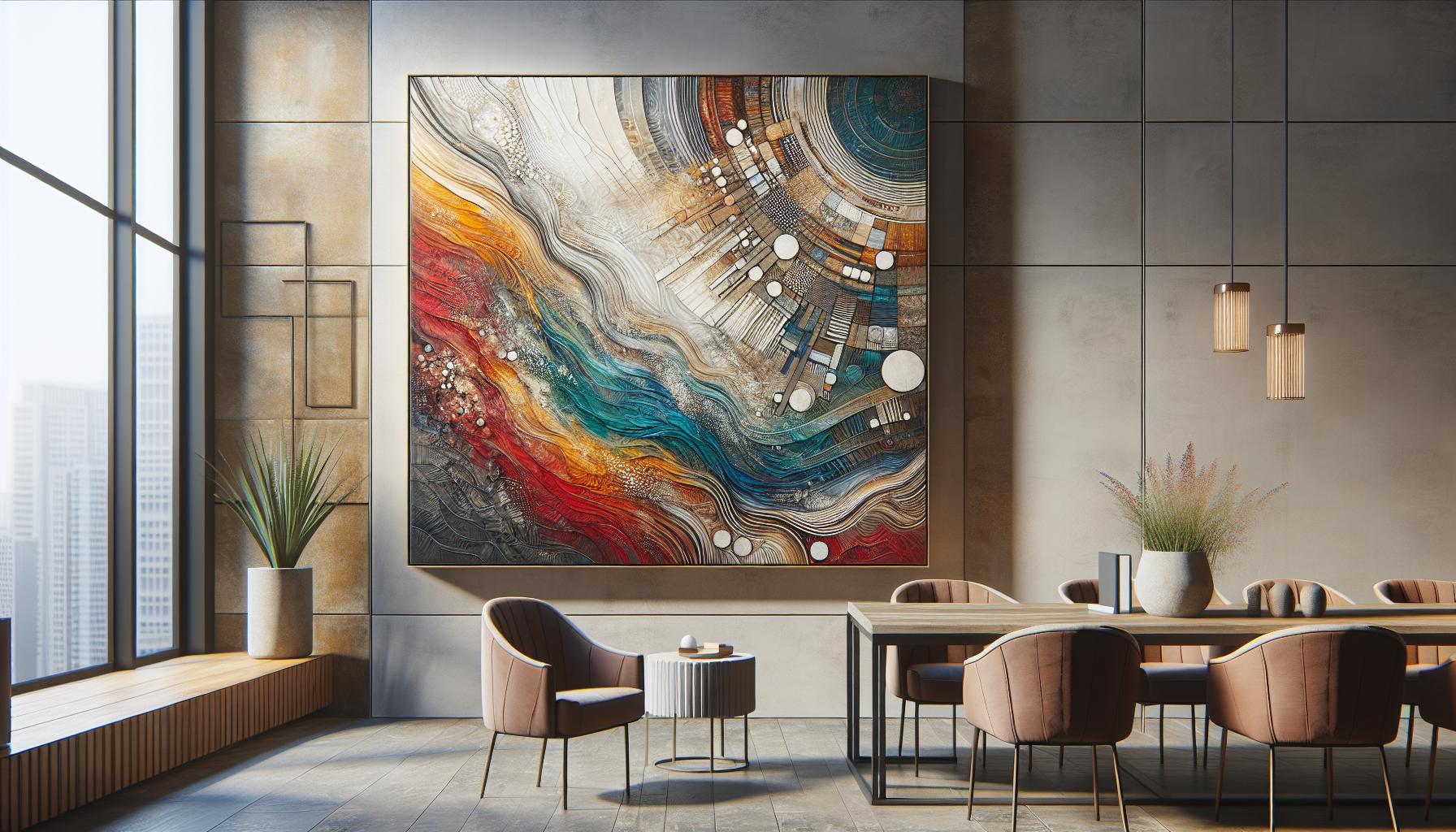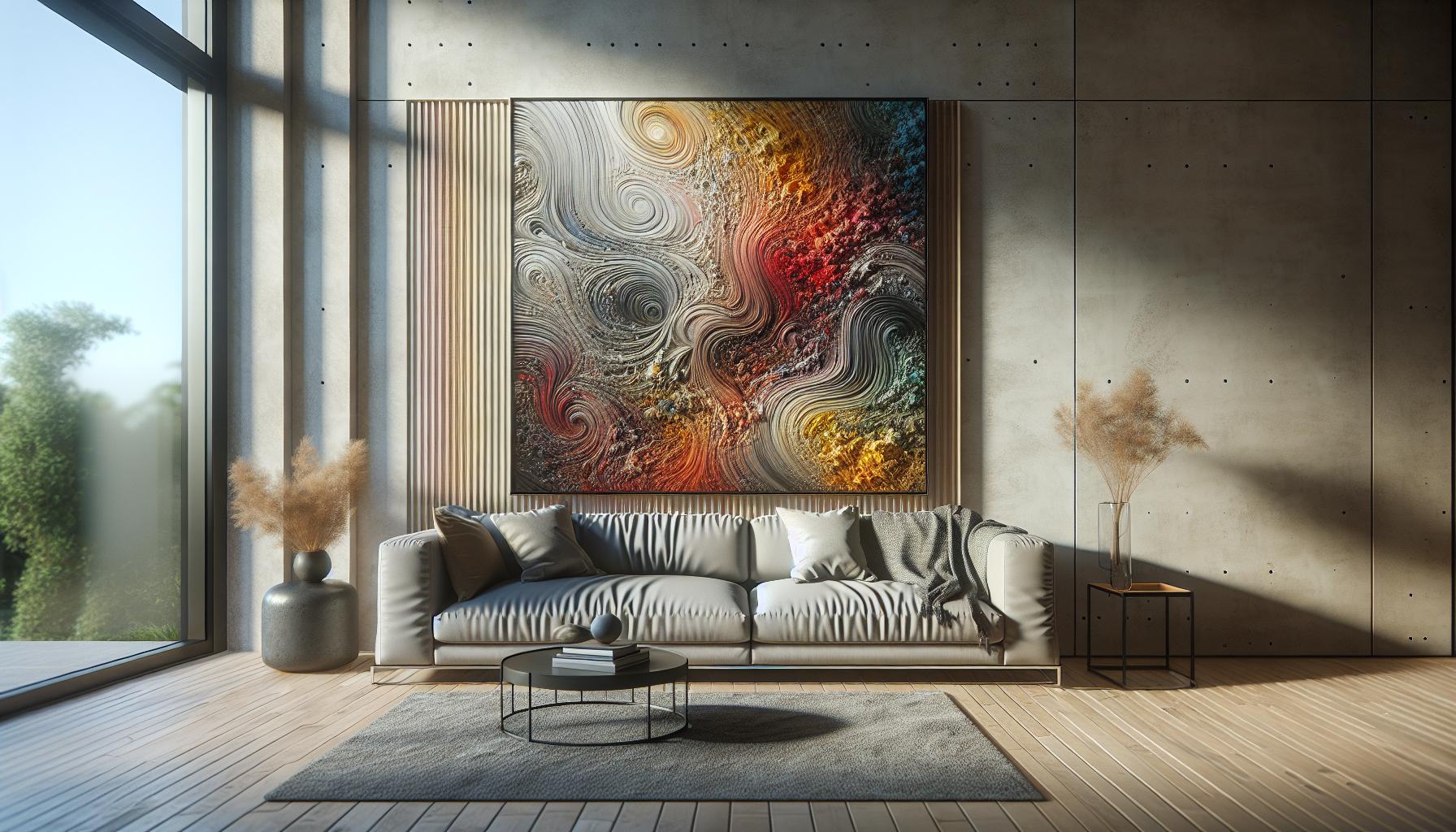Transform bland walls into captivating masterpieces with abstract textured wall art – the perfect fusion of dimension and creativity. Modern interior designers and homeowners are embracing this innovative trend to add personality and visual interest to any space.
Abstract textured wall art breaks free from traditional flat canvas paintings by incorporating mixed media elements reliefs and tactile surfaces. From bold geometric patterns to flowing organic forms these pieces don’t just catch the eye – they practically beg to be touched. Whether it’s crafted from metal wood fabric or unconventional materials like recycled objects this dynamic art form creates an immersive experience that traditional paintings simply can’t match.
Abstract Textured Wall Art
Abstract textured wall art combines sculptural elements with non-representational design to create three-dimensional pieces that engage both visual and tactile senses. Artists layer various materials like acrylic mediums, modeling paste, fabric or metal elements onto canvas or wooden panels to generate depth and dimension.
The defining characteristics of abstract textured wall art include:
- Raised surfaces with peaks valleys ripples or other topographical features
- Mixed media compositions incorporating multiple materials textures
- Non-objective designs focusing on form color pattern rather than recognizable subjects
- Dimensional depth ranging from subtle texture to dramatic relief
- Interactive qualities that change appearance based on viewing angle light
These pieces differ from traditional flat artwork through their:
- Physical protrusion from the wall surface
- Integration of actual texture versus implied texture
- Use of unconventional art materials like sand glass beads metal
- Creation of shadow play through surface variations
- Engagement of multiple senses beyond just visual
Common techniques for creating texture include:
- Impasto application of thick paint layers
- Collage with found objects natural materials
- Carving scratching into applied mediums
- Building up surfaces with modeling compounds
- Embedding textural elements like fabric rope metal
The resulting artwork transforms walls into dynamic focal points where light shadow form material interact to create an immersive artistic experience. Each piece presents unique textural characteristics that respond to changing light conditions throughout the day adding visual interest movement to interior spaces.
Popular Materials and Textures Used

Abstract textured wall art incorporates diverse materials to create multi-dimensional surfaces. These elements combine to form unique tactile experiences that engage viewers beyond visual appreciation.
Mixed Media Elements
Professional artists incorporate multiple materials to achieve complex textures in abstract wall art pieces:
- Metal components like copper sheets, brass strips, steel mesh create industrial textures
- Natural fibers including jute, sisal, hemp add organic depth through weaving patterns
- Found objects such as recycled glass, driftwood, ceramic fragments provide unexpected surfaces
- Fabric materials like canvas, burlap, silk generate soft dimensional layers
- Industrial materials including concrete, resin, plaster deliver structural depth
- Sustainable elements such as bamboo, cork, reclaimed wood offer eco-friendly textures
Dimensional Paint Techniques
Paint application methods create distinct textural effects in abstract wall art:
- Impasto technique applies thick paint layers using palette knives for raised surfaces
- Texture mediums mix with acrylic paints to form peaked ridges patterns
- Pouring methods create fluid organic shapes with high gloss finishes
- Scraping techniques reveal underlying layers through strategic removal
- Stippling applies paint in small dots to build gradual elevation
- Trowel application spreads thick mediums in sweeping geometric patterns
| Tool | Effect | Application |
|---|---|---|
| Palette Knife | Sharp peaks | Heavy bodied paint |
| Texture Roller | Uniform patterns | Mixed mediums |
| Trowel | Smooth planes | Thick compounds |
| Natural Sponge | Organic texture | Layered paint |
Color Schemes and Design Styles

Abstract textured wall art employs strategic color combinations to enhance visual impact and complement interior spaces. Color selection influences the artwork’s mood, depth perception and interaction with ambient lighting.
Monochromatic Compositions
Monochromatic abstract textured wall art creates depth through varying shades of a single color family. Artists layer multiple tones and values, from light to dark, establishing visual hierarchy within the textured elements. Contemporary galleries showcase pieces featuring gradients of blues, grays or earth tones across raised surfaces. Texture variations amplify the subtle color shifts – smooth areas reflect light differently than rough sections, creating dynamic interactions. Metal leaf applications in single metallic hues like copper or silver produce sophisticated monochromatic effects. The interplay between texture and monochromatic palettes generates movement and dimension without relying on contrasting colors.
Bold Color Combinations
Vibrant color pairings in abstract textured wall art create dramatic focal points through strategic contrast. Complementary combinations like orange textures against blue backgrounds maximize visual impact. Artists integrate jewel tones such as emerald, sapphire or ruby into dimensional elements for rich color saturation. Metallic accents in gold or copper introduce reflective qualities that shift with viewing angles. Contemporary pieces combine neon hues with industrial textures for modern appeal. Color blocking techniques separate textured sections into distinct chromatic zones. The strategic placement of bold colors emphasizes specific textural elements while maintaining overall composition balance.
Placement and Display Options

Abstract textured wall art creates dynamic visual impact through strategic positioning. The placement location enhances both the artwork’s presence and the room’s overall aesthetic appeal.
Room-by-Room Recommendations
Living rooms accommodate large-scale textured pieces above sofas at 57-60 inches from the floor. Dining areas benefit from horizontal compositions that span 2/3 of the table length. Bedrooms favor calming pieces positioned at eye level across from the bed. Entryways showcase vertical installations that draw the eye upward through stairwells. Home offices integrate smaller groupings of 3-5 related pieces for focused inspiration. Bathrooms incorporate moisture-resistant textured art in metal or treated materials. Kitchen spaces display compact pieces between cabinets or above countertops.
Lighting Considerations
Track lighting positioned 24-30 inches from the wall surface highlights textural details effectively. Recessed ceiling lights angled at 30 degrees create dramatic shadows across raised elements. LED strips mounted behind pieces produce depth-enhancing wall wash effects. Natural daylight through windows reveals subtle texture variations throughout the day. Picture lights mounted above artwork provide focused illumination for evening viewing. Dimmable fixtures allow adjustable lighting levels to match different times and moods. Gallery-style spotlights direct attention to specific textural features or compositional focal points.
DIY Abstract Textured Art Projects
Creating custom abstract textured wall art transforms ordinary materials into striking focal pieces. The following projects combine accessible supplies with innovative techniques:
1. Mixed Media Canvas Board
- Apply modeling paste in sweeping patterns
- Layer acrylic paint colors with palette knives
- Embed natural materials like sand or coffee grounds
- Add metallic leaf sheets for dimensional shine
2. Textured Paper Collage
- Cut handmade papers into geometric shapes
- Build layers using varied thickness papers
- Create depth with corrugated cardboard pieces
- Incorporate tissue paper for translucent effects
3. Cement Art Panels
- Pour concrete into silicone molds
- Press objects into wet cement for patterns
- Paint finished surfaces with metallic acrylics
- Mount multiple panels for installation impact
4. Fabric Relief Compositions
- Stretch textured fabrics over frames
- Layer burlap with silk for contrast
- Stitch dimensional patterns with heavy thread
- Add beads or buttons for extra texture
- Arrange recycled materials on wood panels
- Secure items with construction adhesive
- Unify pieces with monochromatic paint
- Create balance through object placement
Materials Table:
| Basic Supplies | Textural Elements | Tools |
|---|---|---|
| Canvas boards | Sand | Palette knives |
| Modeling paste | Coffee grounds | Silicone molds |
| Acrylic paint | Metallic leaf | Construction adhesive |
| Paper varieties | Natural fibers | Scissors |
| Cement mix | Recycled items | Paint brushes |
Each project integrates multiple textures to create dynamic visual interest through layering techniques color variations dimensional elements.
Caring for Textured Wall Art
Regular maintenance preserves the beauty of textured wall art. Gentle dusting with a soft microfiber cloth removes surface debris that accumulates between raised elements.
Here’s a systematic approach to cleaning textured wall art:
- Clean monthly with a dry microfiber cloth in gentle circular motions
- Remove cobwebs from crevices using compressed air at low pressure
- Vacuum delicate pieces with a brush attachment from 6 inches away
- Apply art-specific cleaning solutions only on non-porous surfaces
- Test cleaners on a small hidden area before full application
Environmental factors affect textured art preservation:
- Position pieces away from direct sunlight to prevent fading
- Maintain room humidity between 45% to 55%
- Keep room temperature stable between 65°F to 75°F
- Avoid placing near air vents or heating units
- Install UV-protective glass for sensitive materials
Specific materials require unique care approaches:
- Metal elements: Apply specialized metal polish twice yearly
- Fabric components: Steam clean annually using professional services
- Natural fibers: Brush gently with soft bristles quarterly
- Mixed media: Document specific care requirements for each material
- Painted surfaces: Dust weekly avoiding moisture contact
Storage considerations include:
- Wrap pieces in acid-free paper during transport
- Store vertically in climate-controlled environments
- Use corner protectors for framed pieces
- Cover exposed surfaces with breathable fabric covers
- Keep artwork elevated from floor level
These maintenance practices extend artwork longevity while preserving textural integrity.
Abstract textured wall art stands as a powerful medium that transforms living spaces into dynamic galleries of personal expression. By combining tactile elements materials and innovative techniques artists create pieces that engage viewers on both visual and physical levels.
These compelling artworks continue to evolve pushing creative boundaries while offering endless possibilities for interior design. Whether purchased from professional artists or crafted as DIY projects abstract textured wall art remains an influential force in modern home décor that captivates inspires and transforms ordinary walls into extraordinary focal points.
The fusion of texture color and dimension in these pieces ensures they’ll remain a significant trend in contemporary interior design delivering both aesthetic appeal and artistic innovation to spaces for years to come.



